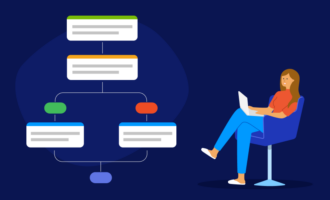When the Agile Manifesto was published in 2001, it addressed the limitations of traditional manufacturing and workflow philosophies, quickly making it one of the most popular approaches to software development.
Even as the agile framework changed software development, its methodologies began influencing the core principles of project management, regardless of industry applications.
The framework’s popularity lies in its transparency and flexibility, as well as its focus on continuous improvement. Project managers frequently recognize that agile’s processes facilitate higher-quality products, better customer satisfaction, improved workflow predictability, and better team morale.
As work becomes increasingly complex and focused on knowledge — both how organizations use it and how people gain more of it — agile helps teams overcome the challenges of today’s marketplace more efficiently and with less stress.
In this post, we’ll explore exactly what an agile workflow is so you can build your own.
The basics of an agile workflow
Agile is an iterative workflow that approaches projects in a series of cycles called “sprints,” which are made up of different stages. Each stage serves a specific purpose and repeats in the same order each cycle.
Though a team’s goals vary from cycle to cycle based on what they need to accomplish or learn, the stages provide a framework for their progress. Teams stay aligned with an initial planning meeting, daily standup meetings during the work process, and a retrospective at the end of each cycle to review accomplishments as well as challenges and their potential solutions.
Perhaps the biggest benefit of the agile workflow is how it organizes the chaotic nature of discovery and creativity that’s so important for software development and every kind of knowledge work.
The basic agile workflow cycle looks like this:
Conception
Project leaders envision the product or changes they want to make to a product. This stage can include intense research and information gathering from the marketplace or customers. This is also when managers plan the upcoming sprints.
Inception
Managers form each team and assign their respective goals and deliverables. They define and communicate project requirements, schedules, and other sprint elements.
Iteration
Developers begin the sprint and tackle their workloads.
Release
At the end of the sprint, customers receive the new product or update and provide feedback. Teams analyze this feedback in the conception phase of the next cycle so managers can map what improvements are needed and where to focus the next sprint’s efforts.
How to create an agile workflow
If you want to tame your chaotic knowledge work environment to create a more consistent workflow, agile could be the perfect framework for your organization. To create an agile workflow of your own, follow this simple, four-step process.
Forming
Before you dive in, make sure you thoroughly understand the principles of agile. The framework’s intuitive nature makes it easy to implement as long as you understand its logic. Review the following with your team:
- The special roles each member will have
- The structure of sprints, including daily standups, planning, and retrospectives
- The basics of continuous improvement and how the cyclical, iterative nature of agile workflows help achieve this
Setting this groundwork will help with the next phase.
Storming
Review your backlog of work and the goals you need to achieve to move forward. Divide them into sprints, being mindful not to try to accomplish too much in too short a time frame. Communicate with your team during this process so you don’t bury them in more work than they can reasonably manage. This is also a great time to be mindful of team roles and what best suits each team member.
Norming
In this stage, assign team members their specific roles. These roles include product owner, product manager, individual workers, and stakeholders (usually outside of the actual team structure but who provide input necessary for completion).
Performing
Put your team to work completing the tasks of the sprint and holding daily standup meetings. Ensure team members meet the obligations of their roles. For example, the product owner should proactively review work and provide feedback according to the sprint requirements and parameters.
Once the team completes the sprint and customers receive deliverables, collect feedback to review with the team during the sprint retrospective. After this meeting, congratulate your team — you’ve completed your first sprint.
Replicate this process again in the next cycle to get more comfortable with it — and repeat it. All you need to do to effectively implement an agile workflow is develop a structure and participate in it.
How to create an agile workflow with Jotform
Implementing a workflow is much easier when you’re using the right tools. Jotform is a great productivity enhancement platform that helps users incorporate forms into robust workflows.
Jotform offers more than 10,000 customizable form templates that help with everything from collecting customer feedback to enabling users to report software bugs. And the database-spreadsheet tool, Jotform Tables, allows you to visually manage team workflows using table templates, a kanban view, and other features.
In addition, with the new Jotform Approvals, you can create forms with conditional logic to feed an approval workflow — such as designing a sprint to fix issues or update product features — so that submissions route to the proper team members for review and response.
Get started with one of more than 100 pre-built approval templates to help streamline how your team reports problems and implements solutions in sprints. Each of these workflow templates are fully customizable, making collaboration among team members and departments easier than it’s ever been.
Business photo created by pressfoto – www.freepik.com





























Send Comment: